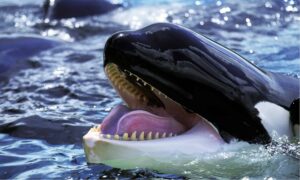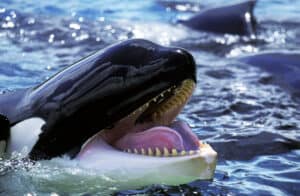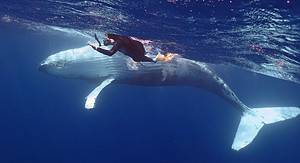Baleen whales are some of the most unique and breathtaking animals in the world. These huge marine mammals are some of the biggest to have ever existed and are found all over the world. Despite their size, these gentle giants are famed for eating only the smallest animals around. Not only that, but they are known for undertaking some of the longest migrations of any animal. Here we’ll discover exactly why baleen whales migrate and where they travel to.
What are Baleen Whales?

Baleen whale have baleen plates instead of teeth
©jo Crebbin/Shutterstock.com
There are fourteen species of baleen whale – including blue, bowhead, right, fin, humpback, minke, and gray whales. Baleen whales are whales that have “baleen plates” instead of teeth. These baleen plates are made of keratin and grow in rows on each side of their mouths. They have bristles on them which act as a filter when the whale is feeding. The length of the baleen differs between species, with the right whale having the longest of them all. Baleen whales have two blowholes rather than one and are also usually much larger than their toothed counterparts. The blue whale is the largest animal to have ever lived and has been known to reach a whopping 110 feet long.
Baleen whales mainly feed on krill, plankton, and small fish. They feed by taking in great mouthfuls of water which is filtered through the baleen plates which catch the krill or fish which the whales then swallow. Baleen whales have two methods of feeding – skim feeding and lunge feeding. When they are skim feeding they swim slowly through swarms of fish or plankton with their mouth open to catch mouthfuls of food. However, some species – such as the blue whale – are lunge feeders and lunge at speed through huge clouds of krill to feed in mass quantities.
Unlike toothed whales, baleen whales are usually solitary or travel in small groups, rather than large, social pods. They don’t use echolocation, instead they communicate using low-frequency sounds known as “songs”which can travel great distances. Even though they are solitary animals, they are usually always within communication range of other members of their species. These communication songs are thought to be used to warn of danger and to find each other for mating.
Where do Baleen Whales Migrate to?
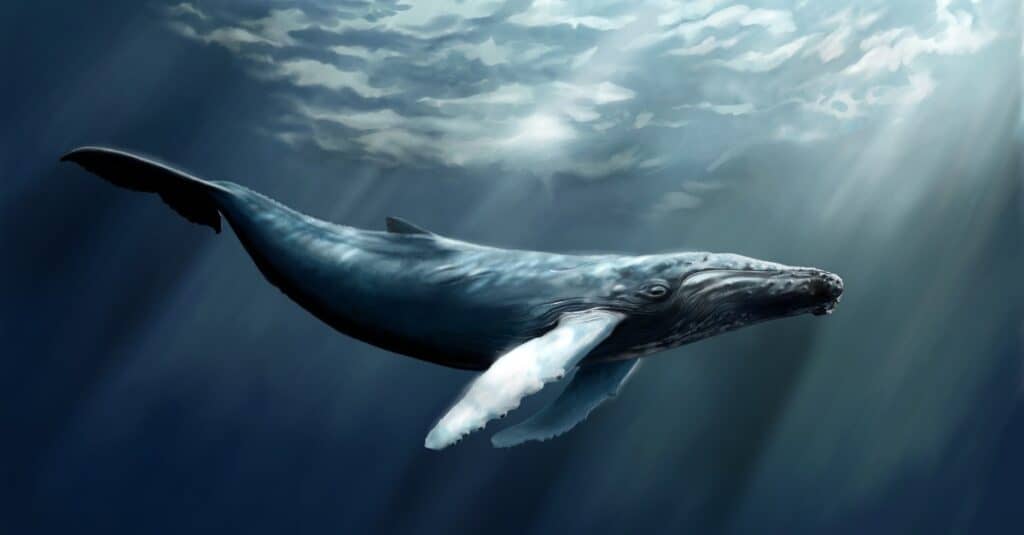
Baleen whales migrate to tropical breeding grounds in the winter
©iStock.com/kenglye
Although baleen whales are found in every major ocean, they are highly migratory. Many species of baleen whales migrate every year from the cold water feeding grounds where they spend the summer to the warm water breeding grounds for the winter. Their feeding grounds are higher latitude areas closer to the poles where the water is colder and the food is much more abundant, while the breeding grounds are closer to the equator.
Baleen whales usually spend between four and six months during the summer in the rich feeding grounds of the polar waters. During this time they eat around 4% of their body weight each day which is much more than they require. All of this excess energy is stored as fat in their thick layer of blubber to sustain them through the winter.
During the winter, baleen whales spend between six and eight months travelling to the tropical waters and giving birth. Throughout this time baleen whales eat much less or even not at all as there is much less food available. On average, they only eat 0.4% of their body weight per day during the winter, instead relying on the fat that they have stored up during the feeding season.
Why do Baleen Whales Migrate?
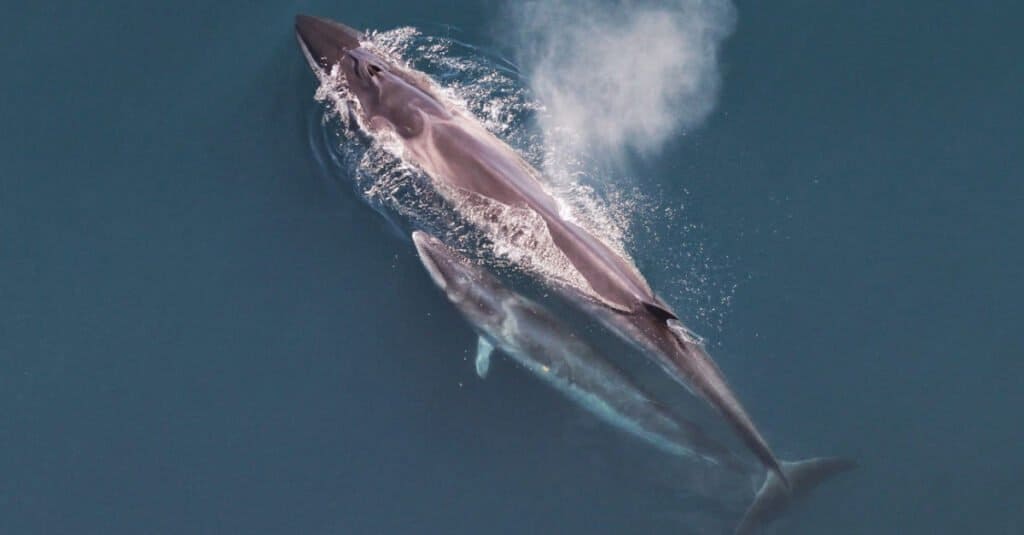
Baleen whales migrate so that calves are born in warmer water
©Christin Khan, NOAA / NEFSC, Public domain, via Wikimedia Commons – License
The main reason that the baleen whales migrate is so that they can give birth in the warmer tropical waters. When baleen whale calves are born they have underdeveloped blubber, which is the layer of fat that keeps them warm. As their blubber isn’t fully developed it isn’t thick enough to keep them warm in colder waters. This means that cold water could kill them. Therefore, by giving birth in the warmer waters, calves have enough time to develop a thick layer of blubber before they migrate back to their cold water feeding grounds.
The other reason that baleen whales migrate to give birth in warmer waters is to protect their calves from killer whales. Killer whales are one of the main predators of baleen whale calves and are apex predators that hunt in packs. Although they can sometimes be found in tropical waters, they usually prefer colder water. This makes tropical waters much safer for baleen whale calves to be born in.
Calves nurse for between 4 and 11 months and stick close to their mothers during the entire period. Nursing calves quickly grow from their mothers milk which has a fat content of almost 50%. During the nursing period, the calves learn many important behaviors from their mother, such as how to feed. Calves are usually weaned in their first summer spent in the feeding grounds and return to the tropical waters alone the following winter.
How far do Baleen Whales Migrate?
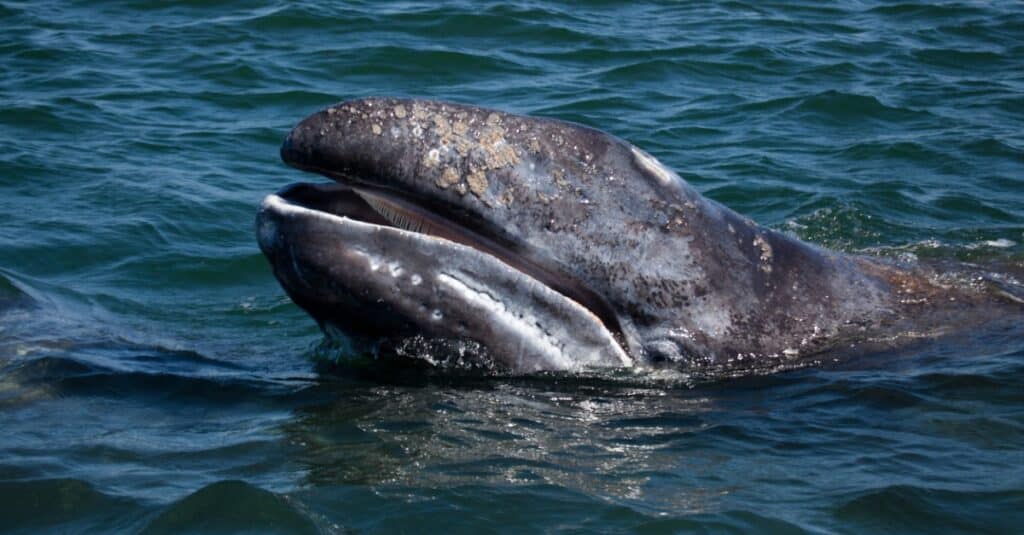
Gray whales have the longest migration of any animal in the world
©Mogens Trolle/Shutterstock.com
Most species of baleen whale travel between 1,800 and 3,000 miles each way. Southern populations of humpback whales leave their Antarctic feeding grounds in January every year and spend three months travelling 3,000 miles to their breeding grounds in the waters of northern Australia.
However, some species actually travel much shorter distances. The feeding grounds of sei whales aren’t as close to the poles so they don’t migrate as far each year. Bryde’s whales prefer warmer waters of 16 degrees Celsius or more (61 degrees Fahrenheit) so they have a shorter migration as they feed in temperate waters and then travel to the equator to breed. However, some populations of Bryde’s whales are classed as “resident” whales. This is because they don’t migrate at all and remain in one area all year round.
Gray Whale Migration: The Longest Migration of Any Animal in the World!
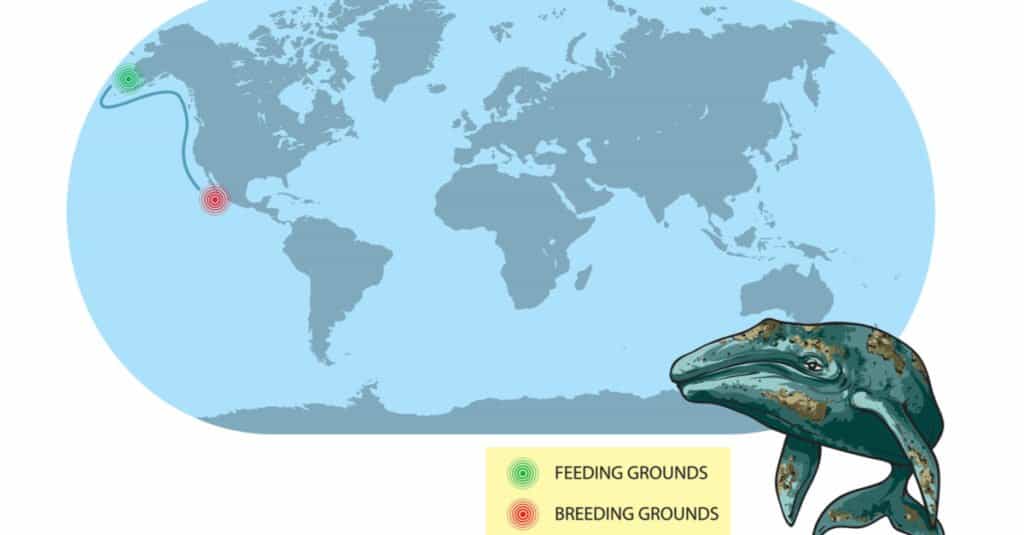
Gray whales have a single migratory pattern
©EreborMountain/Shutterstock.com
Depending on the species and where they are located, some of these migrations can be extremely long. The gray whale has the longest recorded migration, not just of a whale, but of any animal in the world. Gray whales have been recorded as traveling an incredible 14,000 miles from the Sea of Okhotsk to the Baja Peninsula.
Scientists recorded a gray whale migration in 2015 using GPS and were astonished that a 9-year old gray whale named Varvara logged a 13,887 mile journey! Amazingly, while gray whales cover journeys that reach nearly 14,000 miles, they are only three calving lagoons where they give birth to their babies. All are in Baja California.
Blue Whale Migration
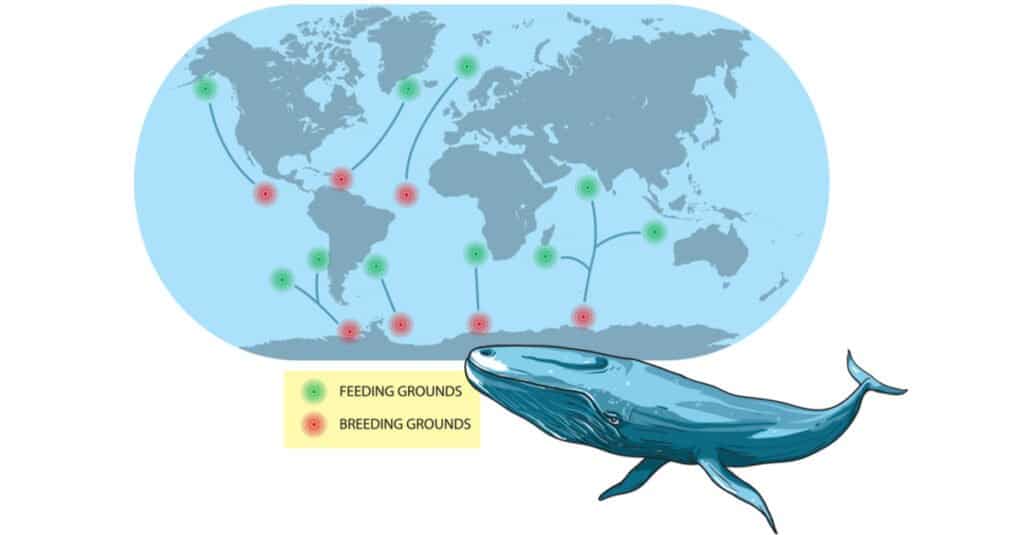
Blue whales have migratory patterns across the world. (Please note the feeding and breeding rounds in the Southern hemisphere are flipped, any dots near the equator are breeding grounds)
©EreborMountain/Shutterstock.com
The migratory patterns of blue whales are much more varied than gray whales and scientists are still searching for many answers into their migrations. For example, the breeding grounds of Southern hemisphere blue whales are still unknown, but are believed to be in the deep ocean across the tropical Indian, Atlantic, and Pacific Oceans. In the Northern Hemisphere, blue whale migrations occur between favored breeding grounds such as Costa Rica and off the coast of California and the northerly waters they travel to to gorge themselves on abundant food.
With blue whales having much less specific migratory patterns, some may even maintain year-round residency in certain geographies.
Humpback Whale Migration
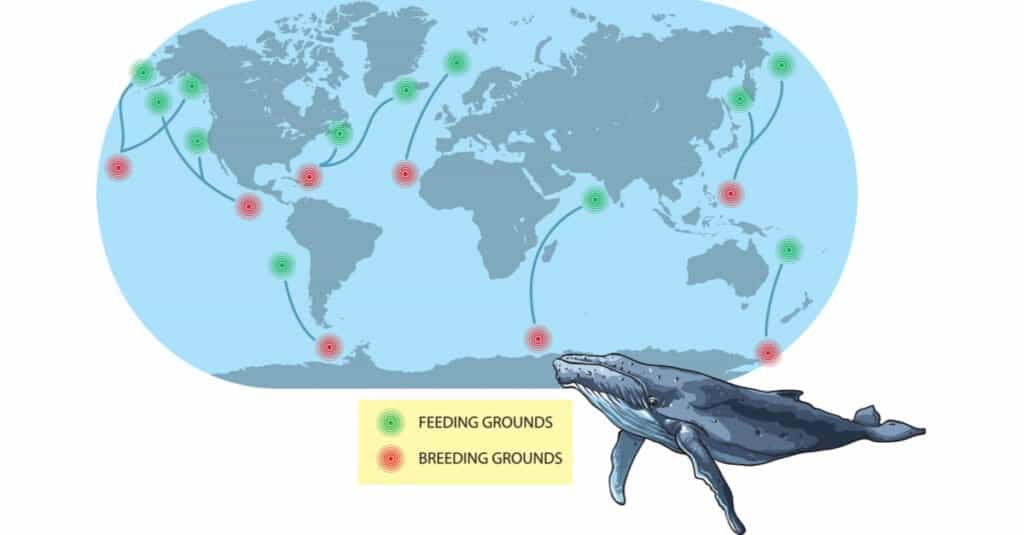
Unlike gray whales, humpback whales have migratory patterns across the world and many breeding grounds
(Please note the feeding and breeding rounds in the Southern hemisphere are flipped, any dots near the equator are breeding grounds)
©EreborMountain/Shutterstock.com
Humpback whales maintain much more varied breeding grounds than gray whales. One popular breeding ground is Hawaii, where about 10,000 humpback whales migrate to each winter when they can be found between November and May. Cabo San Lucas is another popular location for spotting humpback whales during the winter, as humpbacks pass by on their way to breeding grounds in the Sea of Cortez and across the Mexican coast. Other popular breeding grounds for humpbacks are off the coast of Brazil, equatorial Africa on both coasts, along Japan, and Australia’s Queensland and western coasts.
While most humpbacks migrate, its believed that the Arabian sea humpback is the exception. This little-studied group of humpbacks is isolated and appears to not follow migratory patterns seen in other humpbacks.
Are Baleen Whales Endangered?

Several species of baleen whale – including humpback whales – are endangered
©Paul S. Wolf/Shutterstock.com
Sadly, several species of baleen whale are under threat, with blue, right, humpback, and sei whales all classed as endangered. Many of these populations were hunted almost to extinction during commercial whaling operations. However, although large-scale whaling is now a thing of the past there are still many hazards for these magnificent whales.
Collisions with ships are a major factor for some species, particularly blue whales which are often unable to get out of the way quick enough due to their huge size. An increase in the speed of modern vessels in already busy shipping lanes also adds to this risk. As well as ship strikes, baleen whales face threats from pollution, disease, and entanglement in fishing gear.
The photo featured at the top of this post is © EreborMountain/Shutterstock.com
Thank you for reading! Have some feedback for us? Contact the AZ Animals editorial team.



